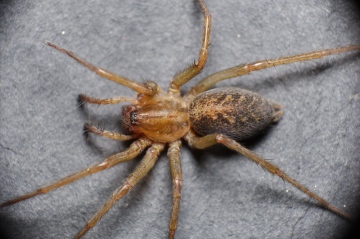Summary for Eratigena agrestis (Araneae)
previous species | next species
National Distribution
Terms of Use. Double-click on map to go to region

Explore Regional Distribution
Please log on and add a note on this species
About this species
Recorded altitude range0m to 281m
Species text
Nomenclature
Bolzern et al. (2013) proposed that Tegenaria agrestis should be placed in a new genus, Eratigena (together with T. picta, T. atrica, T. saeva and T. duellica amongst British spiders).
Distribution
First recorded in Britain from Wilverley Plain, Hampshire in 1949, this species has colonised northwards over the last half century (Merrett 1979). It now has a wide but patchy Distribution: through much of England and Wales, and is colonising Scotland (e.g. Stewart 1987). Elsewhere in Europe it is widespread, extending into Russia, Ukraine and Kirghizia (https://araneae.nmbe.ch/data/80). This species was introduced into the Pacific North-west region of North America in the early 1900s.
Habitat and ecology
Eratigena agrestis in Britain is usually found among sparse grassy vegetation and under stones, particularly on waste ground (e.g. in the centre of cities) and alongside railway tracks. The sheet web extends from the retreat and is supported by vegetation. The egg-sac is a multi-layered structure, one layer of which is often composed of mud and other debris (possibly as a device to deter ant predation). Although not normally a house spider in Europe, this habitat is mentioned by De Blauwe & Baert (1981) for the species in Belgium and it has occurred regularly in a house in Bedfordshire (I. Dawson, pers. comm.). In North America, E. agrestis is very much associated with houses and their environs, commonly frequenting wood piles, garages and spaces beneath buildings (Akre & Myhre 1991). Here a number of serious spider bites have been wrongly attributed to E. agrestis (Vetter & Isbister 2008). Adults of both sexes are found mainly in late summer and autumn.
Status
A successful and colonising species.
Author of profile: Geoff Oxford.
References
Akre, R. D. & Myhre, E. A. 1991. Biology and medical importance of the aggressive house spider, Tegenaria agrestis, in the Pacific Northwest. Melanderia 47: 1-30.
Bolzern, A., Burckhardt, D. & Hänggi, A. 2013. Phylogeny and taxonomy of European funnel-web spiders of the Tegenaria-Malthonica complex (Araneae: Agelenidae) based upon morphological and molecular data. Zool. J. Linn. Soc. 168: 723-848.
De Blauwe, R. & Baert, L. 1981. Catalogue des araignes de Belgique. Bull. Inst. r. Sci. nat. Belg. 53: 1-37.
Merrett, P. 1979. Changes in the distribution of British spiders and recent advances in knowledge of distribution. Bull. Br. arachnol. Soc. 4: 366-376.
Stewart, J.A. 1987. Erigone aletris Crosby & Bishop and Tegenaria agrestis (Walckenaer): immigration through Leith docks in Scotland? Newsl. Br. arachnol. Soc. 49: 8.
Vetter, R. S. & Isbister, G. K. 2008. Medical aspects of spider bites. Annu. Rev. Entomol. 53: 409-429. References
Account last edited by Geoff Oxford at 14:25 on Tue 9th Jan 2024.
Adult Season
Habitats
background methodology
Recorded management for locations with Eratigena agrestis
Recorded substrate and hydrology for locations with Eratigena agrestis
Images
please log on and upload a new image for this speciesSee also A-Z Species Index - A-Z Picture Index - previous species | next species






